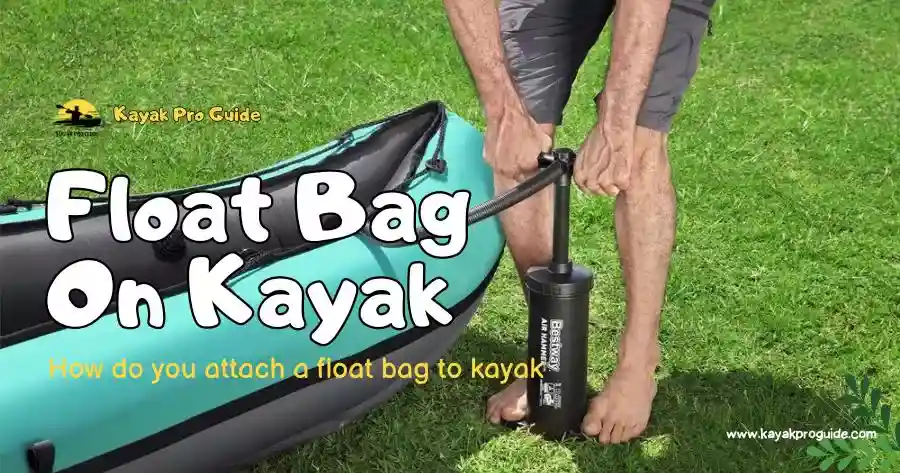Kayaking is an adventure platform. Where everyone is looking forward to enjoying the competition and fun. Generally, kayaking is an extreme sport.
Initially, this sport gained popularity through the Olympics. But nowadays, kayaking is done to enjoy the beauty of the sea. However, are you an adventurous soul who loves the thrill of whitewater kayaking?
Do I Really Need Float Bags Whitewater Kayak? Also, in this blog, I will discuss the flotation bag requirements for whitewater kayakers and provide proper guidelines.
If you are a beginner kayaker, then read the complete blog and get the necessary solution to your query. Let’s start together.
What are kayak float bags used for?
Generally, kayak float bags help keep the kayak afloat if the bottom leaks, hatches open, or water enters for some reason. They are usually made of light, waterproof material and are inflated with air.
Also, float bags are fitted inside the front and rear decks of the kayak. If water enters any part of the kayak, float bags inflate to help keep the kayak afloat. This keeps the kayaker safe.
Moreover, kayak float bags come in different shapes and sizes. Depending on what type of kayaking you are doing will determine what kind of float bags you will need.
Kayak float bags are a helpful protection system for kayaking in challenging water conditions.
Do I really need float bags whitewater kayak?
Basically, float bags are almost always necessary for whitewater kayaking. Especially if you are a beginner or intermediate kayaker, some advanced kayakers feel comfortable taking the risk and kayaking without a float bag. Still, doing so is not generally recommended because beginners may face danger.
Here are a few reasons why float bags are important for whitewater kayaking:
1. Prevention of excessive buoyancy
If your kayak ever capsizes or capsizes in a storm, float bags will help keep the kayak afloat and make it easier for you to get it back up and running.
2. Increase protection
Also, if there is a leak somewhere in your kayak, float bags can help prevent water from entering and keep your kayak afloat.
3. Protect your gear
You can use float bags to store your gear so it doesn’t get soaked in water.
4. Make your kayak more stable.
Float bags can help stabilize your kayak, which is especially important in challenging water conditions. As a result, there is no fear of overturning in large waves.
Finally, whatever flotation device you plan to use, ensure it’s the right size for your kayak and properly inflated.
How do you attach a float bag to kayak?
Generally, float bags are used to ensure the safety of the kayak. Float bags also help protect against ocean waves or storms. However, if the float bag is not installed properly, it poses a risk to the kayak.

Below, you’ll learn how to fit a float bag into your kayak:
1. Choose the right float bag.
First, make sure the float bag is appropriate for the size and weight of your kayak. The bag needs to provide enough buoyancy and be compatible with the kayak.
2. Inflate the float bag.
Open the valve of the bag and empty it by mouth or pump. Most bags have a maximum pressure limit indicated on them, so do not exceed that limit for safety.
3. Attach the bag to the deck of the kayak.
Using the rope or strap that came with the bag, tie the bag firmly to the deck of the kayak. Also, ensure the bag is secure and compatible with the kayak so it doesn’t fall into the water.
4. Adjust the position of the bag.
Place the bag on top of the kayak so it does not affect the weight distribution or hinder your paddling freedom. Although I confirmed, Do I Really Need Float Bags Whitewater Kayak?
5. Check the bag before entering the water.
Finally, ensure the bag is firmly attached to the kayak and inflated.
How do you use a kayak paddle float?
Generally, a kayak paddle float is an important safety tool that helps you re-board your kayak after a capsize. It is light and easy to use and should always be kept with your kayak.
Also, a paddle float is an inflatable bag that can be attached to one end of your kayak paddle. Basically, it helps you float in the water and keep your kayak upright so you can get yourself back into the kayak.
How to use a kayak paddle float:
- After capsizing, position your kayak over the waves. Stabilize the kayak with your feet.
- Take out the paddle float and slide it onto a paddle’s blade.
- Inflate the paddle float. Most paddle floats have two chambers, so make sure both are inflated.
- Stabilize your kayak by using the paddle float as an outrigger. This will help you re-board the kayak.
- Return to the cockpit of your kayak. Gain leverage by using the paddle float.
- Take the water out of the kayak. You can use a billing pump or a sponge.
If you can follow the above techniques correctly, you can use the Kayak Float Bag without risk. So try to use these techniques properly.
How often should you use a float pod?
Generally, there is no specific time limit for the use of float pods. But it is recommended to use it once or twice a week.
However, you can use it until you feel the benefit. Also, how beneficial it is to use a float pod depends on your personal needs and goals.
Some people use float pods to relax or improve sleep, while others use them to relieve pain or enhance creativity. Although you have been confirmed above, Do I Really Need Float Bags Whitewater Kayak?
If you want to start using a float pod, try it once a week and see how your body responds. If you feel it is beneficial, you can use it more frequently.
Frequently Asked Questions
Are float bags necessary for kayak?
A float bag is unnecessary for kayaks but can provide additional protection and buoyancy. Float bags can be handy for long-distance, ocean, or camping kayaking.
Can you use a dry bag as a float?
You can use a dry bag as a float, but it depends on its size and how full it is.
Can a plastic bag float?
A plastic bag can float, but it depends on the size of the bag, the type of plastic used, and how much air it has filled. Small, thin plastic bags probably won’t float, but significant, thick plastic bags can if filled with enough air.
Will a kayak sink if filled with water?
A kayak can sink if it fills with water, significantly if you exceed the weight limit. Every kayak has a maximum weight limit, so it’s important not to exceed that limit for safety.
Related Post
Are fishing kayaks stable
How to clean a kayak
Do you need a life jacket to kayak in Texas
Can you use a whitewater kayak on a lake
How to get into whitewater kayaking
Final Words About Do I Really Need Float Bags Whitewater Kayak?
The above discussion shows that the float bags are a necessary part of the equipment for the Whitewater Kayers. These are provided with an additional layer of protection by preventing your kayaks from being in the water.
However, it makes your padding experience more enjoyable and efficient and helps floating bags with kayak control and strategicity. Also, float bags will provide a lot of help to protect themselves while kayaking.
I hope you have received the correct answer to your question from the above discussion and follow the techniques of using the kayaking float bag.












